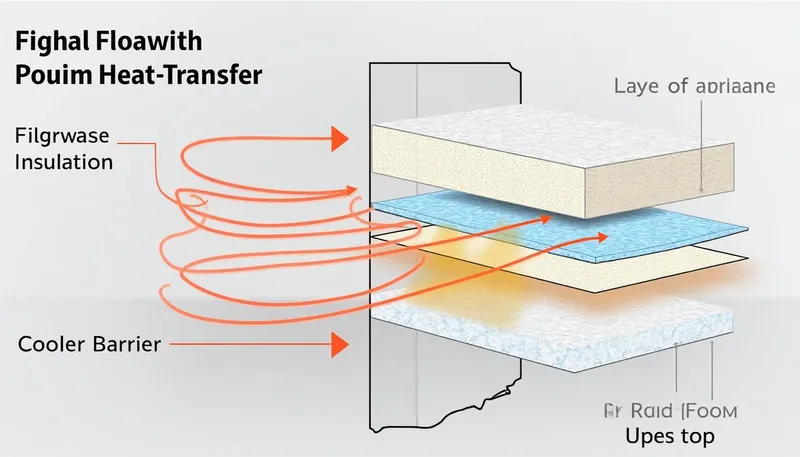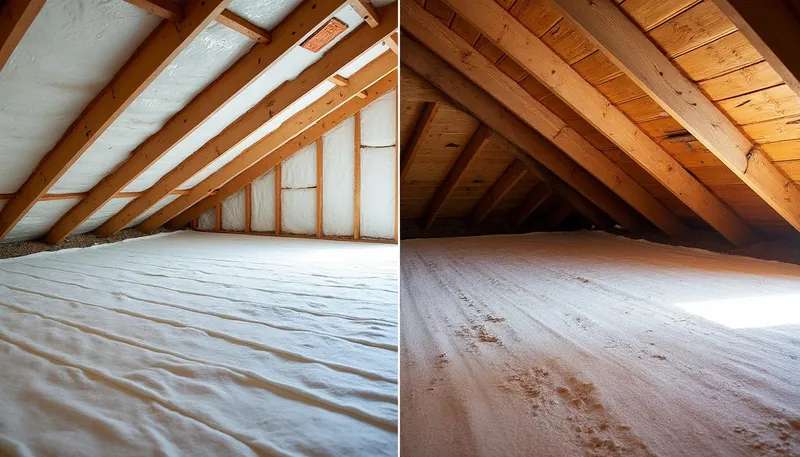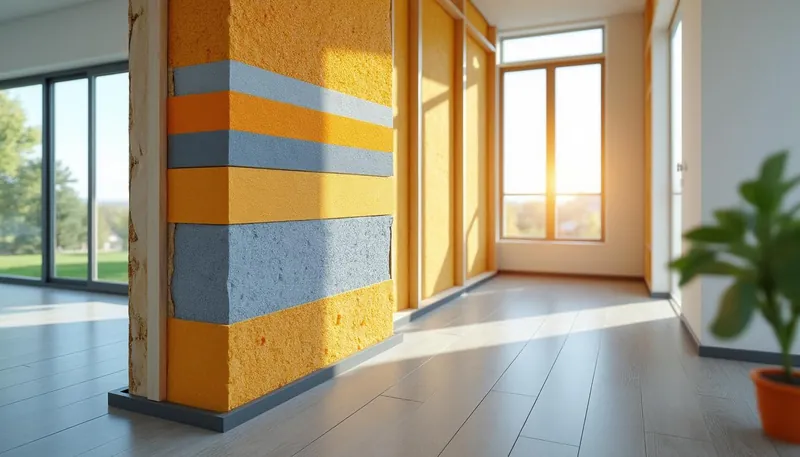When summer hits, and the temperature starts to soar, the struggle to keep our homes cool often turns into a full-blown battle. Among the many strategies homeowners implement to combat the heat, one of the most effective weapons is insulation — specifically, foam insulation. It’s not just about warmth in the winter; proper insulation can significantly impact your comfort during the summer months. By acting as a thermal barrier, foam insulation reduces the heat that penetrates your living space, making it easier to maintain your desired indoor temperature.
In 2025, as energy costs continue to rise, many are searching for solutions to reduce bills without sacrificing comfort. Insulation, particularly products like CoolSeal Foam and EcoChill Insulation, plays a crucial role in enhancing a home’s energy efficiency. Think of your house as a giant cooler in summer: the right insulation keeps the cool air in and prevents the hot air from sneaking in. With the right materials in place, your home doesn’t just stay cooler, it also reduces reliance on air conditioning, which can lead to lower energy costs over time. In this context, it’s essential to explore how foam insulation works and its effectiveness during those sweltering summer days.
In brief:
- Foam insulation acts as a thermal barrier, helping to keep heat out during summer. 🌡️
- Proper insulation reduces the workload on air conditioning units, leading to lower energy bills. 💡
- High-quality products like FoamCool Technologies and ThermoFoam provide optimal insulation solutions. 🔧
- Consistent temperatures throughout the home can be achieved with effective insulation. 🏠
- It’s crucial to assess existing insulation for effectiveness, especially in attics and crawlspaces. 🛠️
The Science Behind Foam Insulation’s Effectiveness
Understanding how foam insulation works to keep your home cool requires diving into the scientific principles of thermal dynamics. At its core, insulation slows down heat transfer, keeping your cool air inside and the scorching heat outside. When installed correctly, foam insulation can significantly enhance your home’s energy efficiency by creating an effective barrier against external heat.
Heat Transfer Explained
There are three primary modes of heat transfer: conduction, convection, and radiation. Foam insulation primarily tackles conduction, which is the process of heat moving through solid materials. When temperatures rise during summer, heat attempts to enter your home through the walls, roof, and even the floor. Here’s how foam insulation helps:
- Conduction Prevention: Foam insulation is designed with a high R-value, which is a measure of thermal resistance. This value indicates how effective the insulation is at preventing heat flow. Higher R-values mean more effective insulation.
- Air Sealing: Quality foam insulation not only insulates but also air-seals. This means that it fills gaps and cracks, preventing warm air from infiltrating and ensuring that your cool air doesn’t escape.
- Radiant Barrier: Some foam insulation products also reflect radiant heat, which helps minimize heat transfer from your roof into your living spaces. Products like ThermaGuard utilize these properties to keep homes cool even in the afternoon sun.
Researchers have indicated that homes with proper foam insulation could see a drop in indoor temperatures by as much as 10°F compared to poorly insulated homes. Alongside this temperature regulation, reduced reliance on air conditioning units leads to a significant decrease in energy consumption. Here’s a simple breakdown of how insulation can impact your home’s energy efficiency:
| Insulation Type | R-Value | Effectiveness in Summer Heat |
|---|---|---|
| Closed-Cell Spray Foam | R-6 to R-7 | Excellent heat barrier, seals air leaks effectively |
| Open-Cell Spray Foam | R-3.5 to R-4 | Good for thick applications, not a moisture barrier |
| Fiberglass Batts | R-2.9 to R-4.3 | Budget-friendly, but less effective than foam |
| Blown-In Cellulose | R-3.1 to R-3.7 | Good for filling gaps, better airflow resistance |

Where Foam Insulation Matters Most
When it comes to insulation, not all areas of your home are created equal. Some spots demand more attention due to their potential for heat absorption. Let’s take a look at where foam insulation can make the most impact during the summer heat waves.
The Attic: The Biggest Culprit
Your attic plays a crucial role in how cool your home stays during hot months. Attics can become extremely hot, with temperatures soaring above 130°F. This intense heat radiates down into the living spaces below and can quickly overwhelming anyone trying to escape the summer heat. Proper insulation in this area is vital for temperature control and should be a top priority for homeowners.
- Type of Insulation: Closed-cell foam is often recommended for attics because it’s incredibly effective at sealing and insulating.
- Combine with Ventilation: Adequate ventilation is also necessary to help dissipate heat. Venting hot air out allows your insulated attic to maintain a cooler environment below.
- Regular Inspections: Check your attic insulation every few years. This helps ensure that it remains effective and no moisture damage has occurred.
Other Key Areas
While attics are commonly addressed, there are other areas in your home that require equal attention for optimal cooling:
- Crawl Spaces: Insulating crawl spaces can help protect against hot air rising through the floor.
- Walls: If your walls lack insulation, especially south- and west-facing ones, they could be absorbing heat throughout the day.
- Garages: Insulating attached garages can create a buffer against heat transfer into your home.
Investing in insulation across these critical areas ensures a more balanced cooling effect throughout your entire home.

Optimizing Your Air Conditioning with Insulation
Foam insulation might not replace your air conditioning, but it certainly amplifies its effectiveness. Properly insulated homes experience several notable benefits, particularly in how their air conditioning systems operate, ultimately impacting energy costs.
How Insulation Enhances AC Performance
When your home is well-insulated, your air conditioning system doesn’t have to work as hard to maintain comfortable temperatures. Let’s break down the mechanics of this relationship:
- Less Frequent Cycling: Effective insulation keeps cool air in and hot air out, meaning your AC won’t cycle on and off as frequently. This reduces wear and tear on the system. 🔧
- Consistent Comfort: With insulation ensuring that every room stays cooler, you’ll experience a more stable indoor temperature throughout your home. 🌡️
- Energy Savings: Proper insulation can reduce summer cooling bills by 15-25%, translating into direct savings for homeowners. 💰
This synergy between your HVAC system and insulation not only helps to maintain a pleasant indoor atmosphere but also prolongs the life of your cooling equipment.
Evaluating the Insulation in Your Home
If you suspect your current insulation isn’t doing its job as effectively as it should, how can you tell? Thankfully, there are several signs that can indicate whether your insulation is Lagging in performance.
Signs Your Insulation Is Falling Short
The following indicators can help assess your insulation’s overall effectiveness:
- Inconsistent Temperatures: If your upstairs feels significantly hotter than downstairs, your insulation might not be doing its job. 🚪
- Rising Energy Bills: A sudden spike in your cooling costs could indicate inadequate insulation. 📈
- Drafts or Air Leaks: If you can feel drafts near outlets or windows, your existing insulation might be compromised. 🔍
| Indicator | Potential Issue | Action Required |
|---|---|---|
| Hot upstairs rooms | Poor attic insulation | Upgrade insulation |
| High energy bills | Insufficient cooling efficiency | Evaluate insulation and AC |
| Drafts near windows | Air leakage | Seal leaks and insulate |
By keeping an eye on your home’s performance, you can take proactive steps to improve its insulation and ensure you stay cool and comfortable all summer long.
Can poor insulation cause my second floor to be hotter?
Yes, insufficient insulation can lead to temperature discrepancies between floors, often resulting in a 5-15°F difference. Proper attic insulation is crucial to mitigate this issue.
Does insulation help manage indoor humidity?
While insulation doesn’t absorb moisture, it limits outdoor hot and humid air from entering your home, improving overall comfort.
How does insulation affect my AC’s operation?
Good insulation keeps cool air in and minimizes hot air infiltration, which enhances your air conditioning system’s efficiency.
Is insulation just a winter solution?
No, insulation is vital year-round. It keeps homes comfortable in both winter and summer by preventing unwanted heat transfer.
Can insulating my garage help with indoor cooling?
Yes! Insulating your garage helps reduce heat transfer into adjoining spaces, improving overall indoor comfort.


